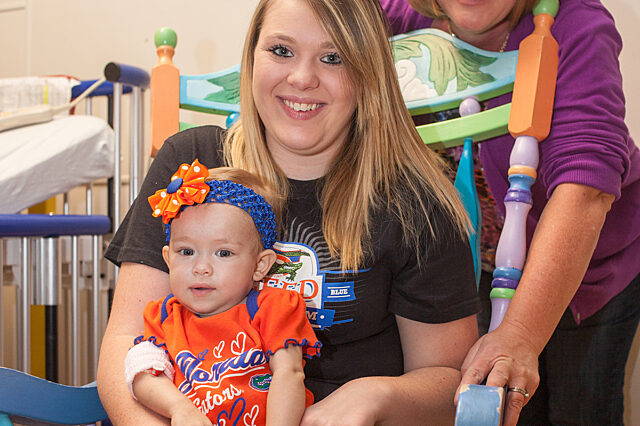Baby who received UF&Shands’ first pediatric liver transplant since program reactivation now thriving

Now that Chelsey Hoyle is rid of her scarred, dysfunctional liver, the 1-year-old can really get down to the business of being a baby.
Chelsey received part of an adult liver during a transplant operation in early November, less than a month before her first birthday. The operation was UF&Shands’ first pediatric liver transplant since the program’s seven-month hiatus and its reactivation in April 2012. The program is one of only two in Florida.
UF&Shands, the University of Florida Academic Health Center, voluntarily suspended its liver and pancreas transplant programs in August 2011 after several transplant surgeons moved to more urban areas. The pancreas transplant program also was reactivated in 2012.
UF surgeons have performed two pediatric liver transplants since the program became active again, including Chelsey’s. Her donated partial liver came at just the right time.
“She was within days of dying," said Jeffrey Fair, M.D., chief of transplantation surgery in the UF College of Medicine’s department of surgery. “She had complete cirrhosis. Her liver was just a little gnarly knot and nothing like a liver at all."
Chelsey developed cirrhosis, or scarring, of her liver due to biliary atresia. The condition occurs when liver ducts that transport bile and other fluids to the gallbladder are malformed and blocked. The resulting backlog causes inflammation and permanent liver damage and hardening. Children with the disease often become malnourished and develop swollen bellies. They all require a liver transplant in their lifetimes.
To keep Chelsey going while she awaited transplant, UF&Shands’ pediatric intensive care unit team performed a procedure known as plasma exchange, which involves withdrawing blood from the body, replenishing its clotting properties, filtering out unwanted substances — as the liver normally does — and returning the blood to the body.
When it came time for surgery, the transplant team accommodated the donated liver portion’s adult size by leaving her abdomen partly open and covering the opening with a patch, “to give the liver time to shrink a little bit," Fair said.
After a while, the team closed the opening in her abdomen entirely. Three months post-transplant, Chelsey is back home in Zephyrhills with her mother, 17-year-old Kaylee Alford; her father, 20-year old Nick Hoyle; and her grandparents, Donna Alford and Terry Alford.
“She is a new baby," Kaylee Alford said. “She was happy before, but now she’s no longer hurting, so she’s just super excited and laughs for no reason. She eats a lot more and she’s doing great. I am more than thankful for how great she’s doing."
Le Jones, R.N., C.C.T.C., program manager of UF&Shands’ adult and pediatric liver transplant programs, said Chelsey “is rapidly acquiring all the developmental stages that a child that age would," after being delayed because of her illness.
Fair emphasized the strength of the pediatric liver transplant program, with its new team of committed and reputable surgeons. He said the program also has enhanced collaborations with UF&Shands’ medical and anesthesia teams. The College of Medicine’s department of pediatrics, led by Scott Rivkees, M.D.; and the department’s division of gastroenterology, hepatology and nutrition, led by Christopher Jolley, M.D., also are integral to the care and recovery of pediatric liver transplant patients at UF&Shands.
Jackson Memorial Hospital in Miami has Florida’s only other pediatric liver transplant program. The next closest such program is in Atlanta.